Lisbon Trams of the Past
Above, left, clerestoried bogie tram 323 at Cais do Sodré in summer 1991 in the livery of the Pingo Doce supermarket chain. Middle, a "caixote" tram at Pc. Comércio, 1984. Right, smartly painted tram 275 at Comércio in 1989.
Until the 1990s trams more than 80 years old were still operating on daily services in Lisbon but, since 1995, the fleet has been broadly reduced to two types - modern Siemens articulated trams and remodelled Standard Trams, also introduced into service in 1995. For details of modern tramway operations in Lisbon please see Part One of this webpage, here.
Tram Gauge
Largely because unlicensed rivals, notably Ripert and Eduardo Jorge, were making use of their 1435mm-gauge tracks, from 1888 Carris installed an almost unique 900mm gauge. Conversion work continued into the 1890s. (Only Linz in Austria has the same gauge today). After 1892, the main rival to Carris was the firm of Eduardo Jorge, with its mule-hauled trams, known as 'carros de chora'. After 1917 Jorge moved to suburban services and continued in business as a coach operator until being subsumed within the nationalized Rodoviária Nacional in 1976.
W.H. Koebel's book, Portugal:Its Land and People published in London by Archibald Constable in 1909 has an interesting account of the rivalry between Carris and Eduardo Jorge, pp.66-71. This includes the following...
"Of the public conveyances, the tramway system stands out first and foremost. ... It is a rather curious fact that so many of the Iberian races have, for some while past, been served with a system of these convenient vehicles, such as we ourselves have only recently commenced to adopt.
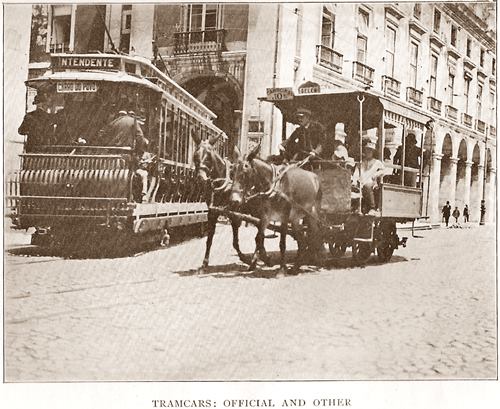 Right: Carris's electric trams competed with Eduardo Jorge's mule cars at the start of the 20th century, as pictured in Koebel's book of 1909 (details above). Here, Jorge's mule car (right) is heading for Belém whilst a Carris "carro do povo" (workers' car) is heading into the city centre of Lisbon.
Right: Carris's electric trams competed with Eduardo Jorge's mule cars at the start of the 20th century, as pictured in Koebel's book of 1909 (details above). Here, Jorge's mule car (right) is heading for Belém whilst a Carris "carro do povo" (workers' car) is heading into the city centre of Lisbon.
The efficiency of the Lisbon service, for one, is undeniable. Tramcars here are ubiquitous. Fearing apparently no gradient whatsoever, they are wont to preform mountaineering feats of no mean order... in perfect tranquility and confidence.
Not content with the exploitation of the main thoroughfares, the daring cars will branch off suddenly and plunge headlong into the complicated netweork of the eastern streets [Alfama]... The speed of the snake-like progress is amazing. Indeed, in order to witness an altogether unsuspected power of agility in the cumbrous modern tramcars, one need go no further than Lisbon.
A number of these cars have in tow a secondary carriage, rather smaller and less imposing in appearance, that is known as the carro do povo, the people's car. The fares of the first are strictly reasonable; but those of the second-class are yet cheaper, and the latter vehicle is patronised entirely by the peasants and poor folk of the town. There are occasions, Sundays and feast-days for instance, when no difference is made betweeen the charges of the two.
It is at such times that the innate modesty of the populace becomes evident. For the great majority, loth to to acknowledge their genuine claim to a seat in the first, insist on crowding themselves together in the second, as on ordinary days, frequently even if the car of superior status be almost empty.
But even the carro do povo is not the cheapest of all the vehicles that ply upon the tramway lines. A very short while spent in the capital will reveal the existence of a number of small vehicles constructed and painted in tramcar fashion, but very much in miniature. Upon their fronts they bear the regulation placards announcing the destination of each, but upon the side is the plain inscription 'Eduardo Jorge'
And Senhor Eduardo Jorge, if he exists in the flesh, is a very enterprising and astute person. One may watch one of these cars as it careers along, as a rule well-laden with pasengers, until it comes face to face with one of the electric ones, a giant by comparison... The mules are flogged to one side; the wheels of the small vehicle slip out of the track, and the conveyance swerves onto the roadway to circle round out of the way of the other and to recover its hold of the lines upon the further side. Meanwhile the other rumbles forward in a stately contempt that is only broken by the expostulations of the driver when the mule-car fails to yield its ground with sufficient promptness...
The small car is a frank pirate upon the rails. It is an institution that preys upon the tramway lines, sharing no expenses with the company for their upkeep. The scheme... is naturally resented by the responsible company. It took the matter to the law courts but was told... that if it chose to leave its rails lying about the streets it could not object to the wheels of other vehicles passing over them...
The company... resorted to a desperate measure and altered the gauge of its lines. Eduardo Jorge.. forthwith amended the width of his axle-bars in proportion and continued to run as before. And so he runs still, undefeated, with his jaunty little cars and their mules...
Yet Eduardo does not get off scot-free. He is recognised by the government to the extent of a tax on each vehicle that represents - would it be believed? - no less than one hundred pounds per annum. But Eduardo Jorge pays it cheerfully, and prospers".
The Historic Tram Fleets of Lisbon
The Horse Trams
Carris started operations on 17 November 1873 using the standard 1435mm gauge on a service (route #1) running every 15 minutes between the Santa Apolónia railway station and Santos, to the west of the city centre. Carris routes reached Belém in 1874, Algés (1878), Rossio (1878), Rato (1879), Poço do Bispo (1888), Lumiar, (1890) and both Benfica and Areeiro (1891). The original route #2 ran from Rato to Corpo Santo,
with branches to Estrela and Príncipe Real. Rossio to Anjos, opened in 1881 was route #3. Most of the early horse-drawn trams were supplied by John Stephenson of New York and known as 'carros americanos'. A depot was built to house the fleet at Santo Amaro (1875) which today remains as the sole Carris tram shed. In that year 3,375,992 passengers were carried, a total which rose to 11,225,487 by 1898. From 1889-92 there was a brief experiment with steam trams. By August 1902 all of the mule-hauled fleet had been withdrawn, following the arrival of electric trams (see below).
The Electric Tram Fleet
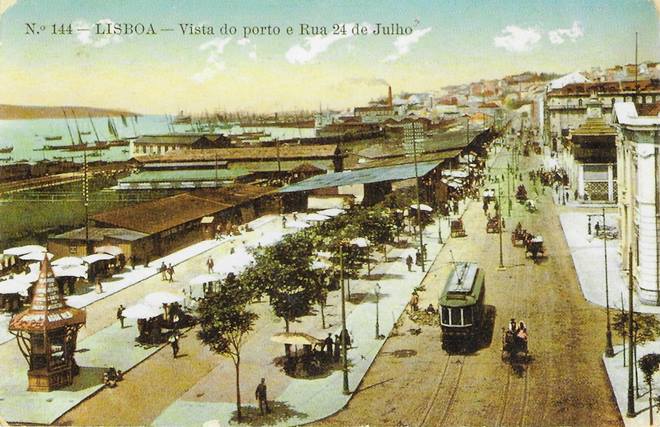
Above: This early 20th-century postcard shows an electric tram on the Avenida 24 de Julho. Note the track repair work going on next to the tram and that Portugal drove on the left until 1928.
Historically the evolution of the Lisbon tram can be divided into four main periods:
1. The American Trams
The term 'carros americanos' was also applied to the electric trams introduced up to 1914. Electrification was organised by the Lisbon Electric Tramway Co, based in London, founded in 1899. Unlike what happened in most of the rest of Europe, Portugal's American trams came directly to the country by ship from the United States, starting in January 1901, rather than being acquired from European agents. Brill of Philadelphia was the predominant supplier, producing both 4-wheel and 8-car vehicles for Lisbon.
The GEC 25hp GE59 motor was the norm for these vehicles. Many of these tramcars were still running into the 1990s, albeit obviously considerably overhauled and/or rebodied since their construction.
#203-82: Ordered in 1899 from Brill in the USA and introduced on 31 August 1901 on the Cais do Sodré to Ribamar (Algés) route along the coast, west of the city centre (today's route 15), these were eight-bench, 32 seater, open-sided vehicles, 7.95m long by 2.32m wide and weighing 7,790kg. As early as 8 September 1901 the network had reached further west, to Dafundo, and a week later, Rossio; by the end of that year it also reached Sta Apolónia (29.9.01), Intendente, Poço do Bispo and Príncipe Real.
Areeiro was reached in April, 1902 and Benfica by 25 May that year. Gomes Freire (Dec. 1905) and Graça (July 1906) were added to the network and today's #12 route at S. Tomé was reached in January 1915. In the 1920s Carnide, Ajuda and Alto de S. João were added to the destinations. However, it was not till 1945 that the Dafundo to Cruz Quebrada extension was opened, west of the city.
The electric 'carros americanos' were withdrawn between 1932 and 1937 but their fleet numbers, 203-82, were reused from 1935 (see below).
#283-322 were 12-bench open-sided Brill trams, weighing 11,380kg and introduced in January, 1902. In length they were 11.33m and were 2.29m wide. They seated sixty passengers with six standing. The class was withdrawn between 1952 and 1955.
They were chiefly used on the long routes, #1 to Benfica and #15 to Cruz Quebrada. From 1954 these fleet numbers were reused, as was their electrical equipment on new trams, the 'caixotes', (see below). 283 survived as an instruction
car till 1961 and then spent twenty years as an attraction in Monsanto park before being rescued for preservation in 1981. It was replaced at Monsanto by tram 525.
#323-342 were eight-wheel Brill bogie cars of 1906, some of which retained their clerestory roofs till their withdrawal in 1996. They were powered by two 25hp motors and weighed 14,442kg. The cars measured
11.78m by 2.36m and seated forty, plus 21 standing passengers. A number were withdrawn in 1931/32 and 1959/61 when the survivors were rebuilt, minus there clerestory roofs. In 1987/88 the fourteen survivors were adapted for one-man operation; of these #330 is now a museum car. In 1995, 342 was sold to Mar del Plata, Argentina.
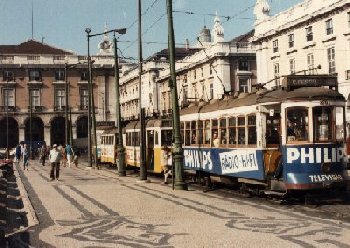
Right: A tram-jam in 1986 in the Praça do Comércio, headed by bogie tram 328, followed by a ligeiro four-wheeler, its trailer and a standard car. Click on images above for larger versions.
#343-362 were also eight-wheeler Brills of 1906 which were reconstructed in 1931/32. They differed from the 323 class in having four 25hp motors. They were also slightly longer (12m) and weighed 18,405kg. They sat forty. A number were withdrawn between 1931 and 1934, whilst all the survivors except 346/48 were rebuilt, without their clerestory roofs in 1959/61. The class survived in use in Lisbon into the 1990s. Car 348 survives in the Carris museum fleet whilst 360 is used as a shelter on the Manx Electric Railway. 355 is now Tourist Tram 10, and for a time was parked in Pç. Comércio for tour booking purposes. In 1998, 343 was sold to Mar del Plata, Argentina. In 2005, 350 was in Córdoba, Argentina.
#363-367 were 1907 workmen's cars withdrawn c.1942. Their trucks and equipment were re-used in #806-810. They were 36 seaters with further capacity for 31 standing. Powered by two 25hp motors they were twelve metres long and 2.29m wide; they weighed 13,710kg. Unfortunately, none survives today.
#389-398 were works cars.
#400-474 were 4-wheelers, with 24 seats and clerestory roofs, built for the hillier routes of Lisbon and ordered from the St Louis tramcar company in the USA and introduced in 1900-01. #435 and 437 became Lisbon's
tourist trams #1 and 2, but the rest of the class was withdrawn; four going in 1935 and 23 more between 1951 and 1963. They had two General Electric motors (25hp each) and controllers
from Dick Kerr of Preston, Lancashire. They weighed 10000kg and measured 8.12m by 2.25m. Number 444 survives with Carris as a museum piece.
#475-499, 503-507 were Brill cars akin to the St Louis 400 class.
Apart from #475, introduced in 1909, they ran from 1912 until 1963, although withdrawals began in 1951. However, number 505 survived till 1972. They had two 25hp motors. They were 8.56m long but widths varied between 2.25m and 2.36m..
#500-502 were Brill 'Radiax' vehicles with 26 seats. They ran from 1914 and were all withdrawn by the end of 1968. They were 10.17m long, 2.28m wide and weighed
12,335kg.
2. The Standard Cars
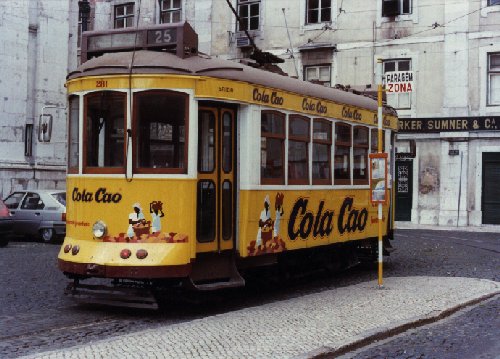
A four-wheeler (281) at Corpo Santo, 1991
During the 1920s Carris's routes expanded north to Carnide and Ajuda, and west to Cruz Quebrada along the coast. Further expansion occurred in the 1930s.
#508-531 were single-ended semi-convertible trams built in Lisbon by Carris in 1924. They survived in service till 1980. Their seating capacity was 24 and they were 8.78m long by 2.36m wide. Their weight was 11,585kg. During the 1960s they were converted to unidirectional cars.
#532-551 were built in 1928, with two Metrovick 45hp motors on Maley trucks. They were withdrawn in 1990. They were 8.382m by 2.378m and weighed 10,560kg..
#552-571, as 532 class, but built in 1931, with Metrovick motors and slightly lighter at 10,048kg. The final fifteen were withdrawn by 1985 and rebuilt (see below). Although they were bidrectional, they often pulled trailers and were used on the hillier routes also.
#601-612 were longer vehicles (9.14m by 2.33m) built, in 1927. They weighed 10,900kg and sat 28 passengers. Used on the hillier routes, they were withdrawn finally in 1972.
#203-282 and 415, 455, 467, 468, 483 were similar to 532. They were built in 1935 to replace the 1900 Brill cars with the same numbers.
#305,327-29,338,340,345,353,355,356 were lightweight bogie cars built by Carris from 1931-35 and withdrawn finally in 1996. All except the last four numbers above had two 25hp motors; the latter had four such motors. Their weights varied up to 17,575kg. Their dimensions were 11.57m by 2.37m.. Tram 305 has been acquired by the
Llandudno and Colwyn Bay Tramway Society, in North Wales. The Society's website's homepage is here. Its body was overhauled at Society premises and the Society's web-pages describe this process, whilst the bogies and running gear have been retained for possible future use under either Llandudno and Colwyn Bay Electric Railway tram No.6 or No.7. The body, in green Ll&CBERly livery, was loaded for transport from North Wales on Saturday 31st May 2008. It went via lorry and ferry to Ireland on 31 May 2008 and by 2011 it was located in an Irish field, still in Llandudno and Colwyn Bay colours. By 2016 it had been
converted into "The Tram Cafe" in Dublin. The bogies and running gear have been retained by the Ll&CBTramSoc for possible future use".
#613-617 were largely as 532, but built in 1935 for the Estrela route. They had two 45hp Metrovick motors and measured 8.382m by 2.378m, with a weight of 10,730kg. In 1985/87 they were converted to one-man operation and ran frequently on the hilly route 28. 720 became a Carris museum car.
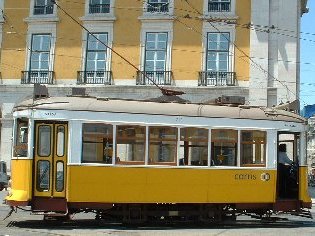
Right: Tram 713 in June 2002.
#701-735 were largely as 532, but built in 1936-40 for the steeper routes. They were later converted to one-man operation. No.730 has been restored at Birkenhead, England, where it runs on standard gauge track. for the Merseyside Tramway Preservation Society. For photos, see here. No.715 has been acquired by the Hampshire Industrial Archaeology Society in England.
By January 2012, the remaining 700s were stored in Sto Amaro shed, where they were due a major service. A number of long-term withdrawn 700s were included in their number, namely 713, 733 & 742, plus tourist trams 3 & 4, as well as 732, which had a broken axle.
#801-810 were 8-wheeler bogie trams, seating 36 people.
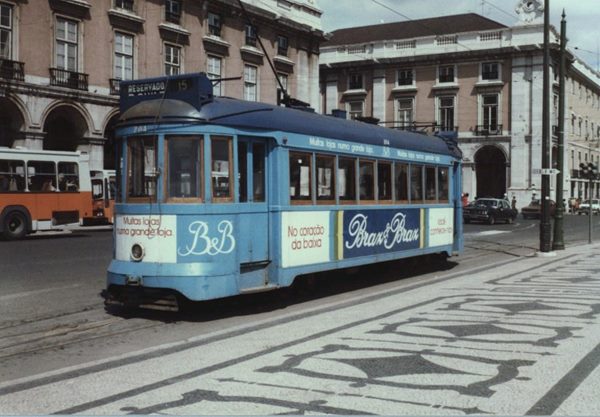
Right: Tram 804 pictured in 1984.
801-5 were built in 1939 on Maley trucks, whilst WWII necessitated the use of recycled Brill bogies when 806-810 were built in 1943. The latter group had two 25hp motors whilst the pre-War batch had four motors. Their size was 11.579m by 2.378m; the heavier four-motor version weighed 15,905kg against 14,400kg for the two-motor type. They had folding doors from the onset and streamlined bodies. In 1963 they received roof-mounted route boards to replace those mounted below the windscreen when built.
802 was withdrawn in 1978 but the rest survived in service till 1993/94. One survives in the Carris museum fleet.
3. The Lightweight Trams, (Ligeiros), 1947-1964.
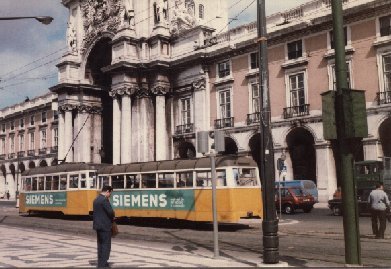
Right: Ligeiro tram and trailer in Praça do Comércio
The tram network was at its maximum from 1958-60 following an extension to Alto de S. João, and totalled 76 route kilometres, 145 track km., plus a further 15km of depot track. The fleet comprised 405 electric trams and 100 trailers. Ordinary fares remained static from 1926 to 1962.
The Lightweight cars, built by Carris, has as their most obvious features their straight sides and ends, which give them an angular appearance. The 4 and 8 wheeled trams of this period have fared less well than their earlier relations, as all have now been withdrawn. They comprised
#736-745 were 4 wheelers, built in 1947 and based on post-War German designs, on Maley & Taunton trucks with two 45hp motors. Despite their flat ends and angular bodies, they were internally similar to the 701 class and measured 8.467m
by 2.378m.. They seated 24 passengers. They survived in use till1985/86.
#901-910 were longer vehicles built in 1947 on Maley trucks, seating forty passengers. Some were built on bogies ordered for 801-06 before the War. They were powered by four 25hp motors and ran in service till 1989, except for903 which succumbed in 1978. Their narrow entrances precluded their conversion to one-man operation.
904 survives as a museum car at Santo Amaro and 910 was sold to Japan.
#100-200 were 4-wheel trailers, (for details see below).
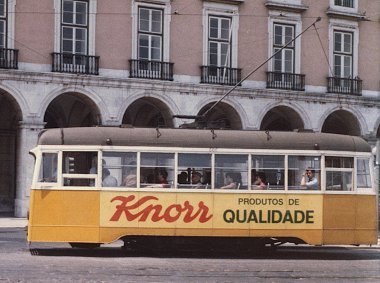
Right: A Caixote.
Right, Caixote #506
#283-322, known as 'caixotes', were as 736-745, using 25hp motors off the retired cross-bench bogie cars. All were built 1954-57 except 283 which was constructed in 1962. They measured 8.467m by 2.378m and weighed 9,585kg. and seated 26.
#609-610 were single-ended 25hp cars.
#403-507 These are 26 seat single-ended cars built between 1952 and 1964 with folding-doors. They were based on earlier vehicles in the 400-507 sequence which were rebuilt as above. Tram 466 is seen, right, at Praça do
Chile.
4. The New and Remodelled Trams, 1985 to date.
#761-763, 771-85
From 1985 to 1987 a number of old cars were rebuilt as unidirectional vehicles and these ran till 1996. They were given two 45hp motors. Their dimensions were 8.382m by 2.378m and weighed 10,000kg. They accommodated 24 passengers, seated, and 18 standing. Their origins were as follows:
761: comprised the body of 276 and the truck of 736,
762: ditto, using 226 and 739
763: ditto, using 568 and 740
771 was based on 557; 772 on 554; 773 on 561; 774 on 563; 775 on 553;
776 on 562; 777 on 566; 778 on 571; 779 on 555; 780 on 565; 781 on
567; 782 on 560; 783 on 564; 784 on 559; 785 on 556.
#737,738,741-45
These were adapted in 1987 from the earlier cars of these numbers. They were bi-
directional and had two 45hp motors. They had 24 seats and weighed 10,730kg.
#501-510 These comprise ten three-section trams built by Siemens and used exclusively on the coastal route #15 to Algés from Praça da Figueira. For details see Part One of this webpage.
#541-585 These are the new numbers for 45 remodelled trams drawn from 221-282 series and from 701-724, but also including 415 and 483.
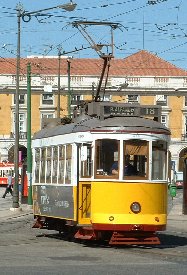
Right: Remodelado tram 576.
|
541 (formerly 270)
542 (241)
543 (230)
544 (236)
545 (277)
546 (227)
547 (273)
548 (228)
549 (221)
|
550 (formerly 278)
551 (235)
552 (242)
553 (237)
554 (264)
555 (246)
556 (?*)
557 (240)
558 (243)
|
559 (formerly222)
560 (238)
561 (483)
562 (275)
563 (261)
564 (266)
565 (245)
566 (265)
567 (281)
|
568 (formerly 254)
569 (257)
570 (244)
571 (223)
572 (255)
573 (272)
574 (247)
575 (267)
576 (415)
|
577 (formerly 252)
578 (225)
579 (702)
580 (262)
581 (724)
582 (701)
583 (714)
584 (707)
585 (719)
|
Footnote: *556 - 256 is often stated to be tram 556's source but David Gourlay reports that it is actually either 240 or 246, so the numbers may be transposed with the source of 557.
Trailers

Tram and trailer in the Praça da Figueira
The last trailers were withdrawn in 1989. They can be grouped into two categories:

Right: One of the 'new' trailers, #155, behind tram #550 at Belém on route 15 in June, 1989.
'Old'
Numbered 153-202, these were Brill vehicles which ran from 1901 to 1953/55. Measuring 7.12m by 1.970m, they weighed 3,320kg and accommodated 32 sitting and 18 standing.
'New'
Numbered 100-200 and built by Carris, these ran from 1950 to 1989. Their dimensions were 8.436m by 2.378m and they weighed in at 4,500kg. They had seats for 28 and space for the same number of standing passengers. They had flush sides like the 'caixote' trams.
Twenty-three survived till 1988/89. In 1999, trailer 173 was placed on a display plinth at Belém, adjacent to the tram turning loop.
Zorras
Zorras are works tramcars used for track repair and transport of materials, tools etc. Their fleet numbers are prefixed by the letter Z. Carris also now has a modern fleet of 'Pronto Socorro' vans and trucks, with fleet numbers which are prefixed by 'PS'.
Carris Museum of Transport
For full details of the Carris Museum, at Santo Amaro, see the Luso Pages Carris Page. This houses trams, buses and other artefacts.
Old Tram Routes
It is hoped to expand the following section in due course to reflect the changing pattern of tram routes in Lisbon.
1898 Baedeker: Spain and Portugal
This lists the following tram routes. The numbers are Baedeker's and NOT route numbers carried by the trams.
- Rua Caminhos de Ferro via P Comércio or from Rossio via Largo do Município to Corpo Santo, Largo de Conde Barão, Santos, Alcântara, Belém, Pedrouços and Algés. "Some cars run to Alcântara via Rua Vinte e Quatro de Julho passing the Estação Cais do Sodré and Est. de Santos".
- Largo de Conde Barão via Rua de S. Bento, Largo do Rato, Largo Príncipe Real, Rua do Alecrim to Rossio.
- Rossio or Calçada da Lavra via Largo do Intendente, Campo Pequeno, Campo Grande to Lumiar.
Fares within the town 30 to 50 reis, to Belem, there and back 80 reis, to Campo Grande 80 reis and to Lumiar 100 reis.
Elevadores:
- Calçada da Lavra to Travessa do Convento de Sant'Anna. Fare 20 reis
- Calçada da Glória to Rua de S Pedro de Alcântara. Fare 20 reis
- Rua da Palma to Largo da Graça. Up 40 reis, down 20 reis, up and down 50 reis.
- Pc Camoes to S. Bento (20 reis) and Largo da Estrela (50 reis)
- Calçada da Bica to Rua da Bica de Duarte Bello. 20 reis, transfer to Estrela 50 reis.
1924 Guia de Portugal: 1 Generalidades, Lisboa e Arredores
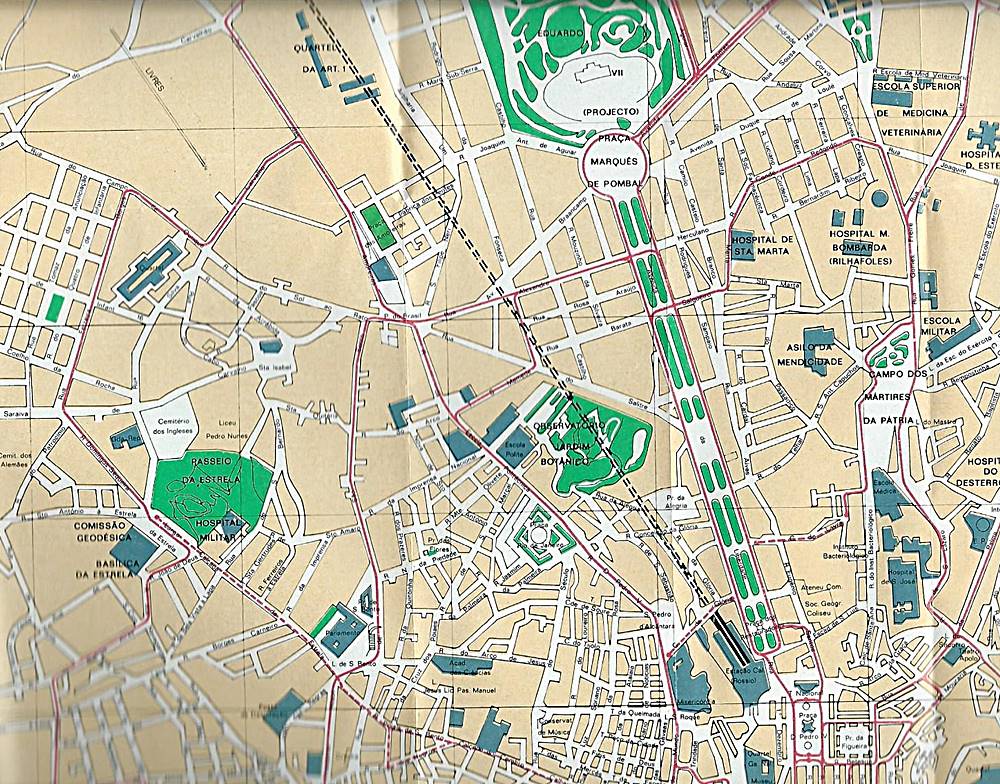
Above: Lisbon tram routes north of Rossio in 1924.
This excellent guide, first published in 1924 but reprinted in 1979, has a lot of detail about the Lisbon tram routes operating in the 1920s. It states that in 1924 there were 108.5km of tram lines. It also explains that trams made an obligatory stop at the "Zona" signs which hung from the overhead at major points on each route but that where a "Paragem" sign hung, stops were only made if passengers on board rang the bell once or awaiting pasengers raised their hand.
It lists the following routes, after which the letter Z prefixes the zone number and its distance from the start of the route. The numbers before each route are NOT Carris route numbers but are simply shown here to distinguish one route from another. There were no route numbers displayed at the time.
- Restauradores - Benfica: Z1 1.516km Pç Marquês de Pombal / Z2 2.594 São Sebastião da Pedreira / Z3 4.512 Jardim Zoológico / Z4 5.817 Estrada de Calhariz/ Z5 7.242 Benfica
- Restauradores - Lumiar: Z1 1.516km Pç Marquês de Pombal / Z2 2.568 Pç Duque de Saldanha / Z3 3.44 Campo Pequeno / Z4 5.647 Campo Grande/ Z5 7.533 Lumiar
- Circulação, Rossio - S. Sebastião - Rossio: Z1 1.696km Pc Marquês de Pombal / Z2 2.774 S Sebastião da Pedreira / Z3 3.764 Pç Duque de Saldanha / Z4 4.836 Pç Marquês de Pombal / Z5 6.532 Rossio
- Campo Pequeno - C Ferro: Z1 Pç Duque de Saldanha / Z2 Pç Marquês de Pombal / Z3 Rossio / Z4 5.76 Caminho de Ferro
- Rossio - Graça: Z1 1.575km S. Tomé / Z2 2.732 Graça
- Belém - Av. Almirante Reis: Z1 2.273km Santo Amaro / Z2 4.640 Santos / Z3 7.101 Rossio / Z4 8.197 Rua dos Anjos / Z5 9.327 Almirante Reis
- Alcântara - Alto do Pina: Z1 2.612km Santos / Z2 4.073 Betesga / Z3 5.159 Rua dos Anjos / Z4 6.299 Almirante Reis / Z5 7.966 Alto do Pina
- Sto Amaro - Arco do Cego: Z1 2.466km Santos / Z2 4.927 Rossio / Z3 6.023km Anjos / Z4 7.750 Arco do Cego
- Belém - C. de Ferro: Z1 2.273km Santo Amaro / Z2 4.640 Santos / Z3 6.461 Terreiro do Paço / Z4 8.234 Caminho de Ferro
- Rossio - Areeiro: Z1 1.472km Anjos / Z2 2.602 Almirante Reis / Z3 3.993 Areeiro
- Largo do Carmo - Campolide: Z1 1.713km Pç do Brasil / Z2 2.874 Campolide
- Rossio - Poço do Bispo: Z1 2.117km C. de Ferro / Z2 4.152 Xábregas / Z3 6.296 Poço do Bispo
- Gomes Freire - Rossio: Z1 1.176km Santa Marta / Z2 2.553 Mártires da Pátria / Z3 4.109 Rossio
- Dafundo - Campo Pequeno: Z1 0.903km Algés / Z2 3.275 Belém / Z3 5.548 Santo Amaro / Z4 7.915 Santos / Z5 10.209 Rossio / Z6 Alexandre Herculano 11.487 / Z7 Saldanha 12.696 / Z8 Campo Pequeno 13.852
- Pç do Rio de Janeiro - Rossio: Z1 1.278km Alexandre Herculano / Z2 3.388 Duas Igrejas / Z3 5.042 Rossio
- Pç do Brasil - Rossio: Z1 1.912km Av do Presidente Wilson / Z2 3.466 Pç do Brasil / Z3 5.042 Duas Igrejas / Z4 6.514 Rossio
- Estrela - Rossio: Z1 1.278km Alexandre Herculano / Z2 3.005 Campo de Ourique / Z3 4.266 Estrela /Z4 5.775 Santos / Z5 8.048 Rossio
1956 Hachette World Guides, Portugal, Madeira, Azores
The above book lists the following Lisbon tram routes as operative in 1956.
- 1. Restauradores-Benfica
- 1A. Restauradores-Jardim Zoológico
- 2. Restauradores-Lumiar
- 2A. Restauradores-Campo Grande
- 3. Campo Grande-Caminho de Ferro
- 3A. Restauradores-Campo Pequeno
- 4. Duque d'Avila-Circulação-S. Sebastião
- 5. Duque d'Avila-Circulação-Saldanha
- 6. Restauradores-Pc Figueira via Gomes Freire
- 8. Martim Moniz-Areeiro
- 9. Pc Comércio-Poco do Bispo
- 10. Graça-Circulação-Se
- 11. Graça-Circulação-Anjos
- 12. Martim Moniz-S Tomé
- 13. Restauradores-Carnide
- 14. Restauradores-Campolide
- 14A. Restauradores-Campolide via L. do Rato
- 15. Pç do Comércio-Dafundo
- 15A. Pç do Comércio-Alges
- 15B. Pç do Comércio-Cruz Quebrada
- 16. Belém-Xábregas
- 17. Belém-Pç do Chile
- 17A. Belém-Alto de S João
- 17B. Martim Moniz-Pç do Chile
- 18. Pç do Comércio-Ajuda
- 18B. Corpo Santo or Pç do Comércio-Boa Hora
- 19. Santo Amaro-Arco do Cego
- 20. Cais do Sodré-Rossio
- 22. S. Bento-Circulação-Conde Barão
- 23. S. Bento-Circulação-Largo do Rato
- 24. Carmo-Pç do Chile
- 25. Estrela-Circulação-Santos
- 26. Estrela-Circulação-Largo do Rato
- 28. Rua da Conceição or Rossio-Prazeres
- 28A. Rua da Conceição-Estrela
1971 Guia Informativo do Serviço de Autocarros (Carris)
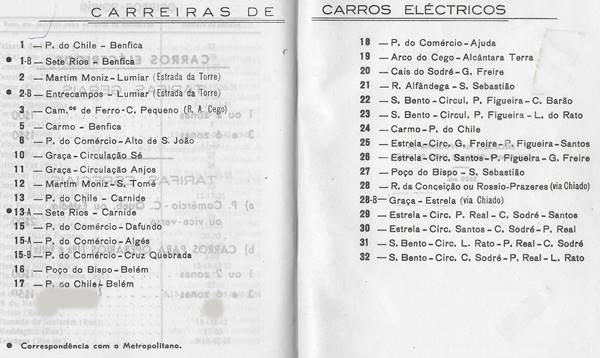
The official Carris bus and tram guide for 1971 contained a list of the tram routes operative at that time, which is reproduced, above. In 1973 the 17 terminus at Praça do Chile was extended to Alto do São João.
1979 Guia Informativo de Autocarros e Eléctricos (Carris)
The 1979 edition included timetables for the following tram routes:
- 3 Poço do Bispo - Arco do Cego
- 10/11 Graça circular
- 12 Martim Moniz - São Tomé
- 15 Pç Comércio - Cruz Quebrada or Estádio Nacional (Jamor)
- 16 Poço do Bispo - Algés
- 17 Alto de São João - Belém
- 18 Praça do Comércio - Ajuda
- 19 Arco do Cego - Alcantara Terra
- 20 Cais do Sodré - Gomes Freire
- 22 São Bento-Circulação-P. Figueira - Conde Barão
- 23 São Bento-Circulação-P. Figueira - Campo Mártires da Pátria
- 24 Carmo- Rua da Alfandega
- 25 Estrela - Gomes Freire (circ. P Figueira -Santos)
- 26 Estrela - Gomes Freire (circ. P Figueira -Campo Mártires da Pátria)
- 27 Poço do Bispo - Campolide
- 28/28A Rua da Conceiçã0 - Parada doa Prazeres
- 29 Estrela - Príncipe Real (circ. C Sodré - Santos)
- 30 Estrela - Príncipe Real (circ. C Sodré - P. Real)
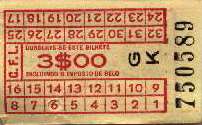
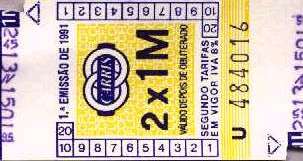
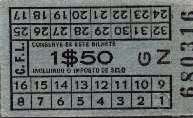
L to R: A 3$00 ticket (1971); a 1991 ticket; a 1$50 ticket (1971).
The single-journey tram fares in 1971 were as follows...
- 1 or 2 zones: 1$00 (NB the $ sign denotes the Portuguese escudo, NOT the US dollar, and the symbol is written between the figure for escudos and centavos and not preceding the overall number)
- 3 to 6 zones: 1$50
A "tarifa especial" (special fares) applied on the P. Comércio to Cruz Quebrada/Estádio route: 2$00
Likewise, special fares applied on "carros para operários" the successor to the "carros do povo" mentioned elsewhere on this page. These fares were 1$00 for any return journey of 1 or 2 zones and 1$50 for a journey of 3 to 6 zones.
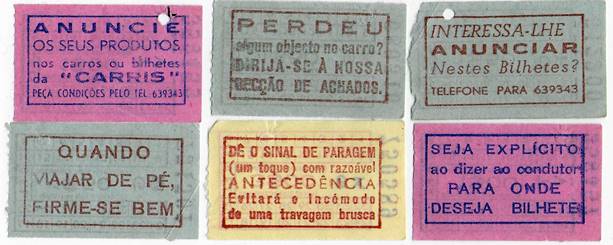
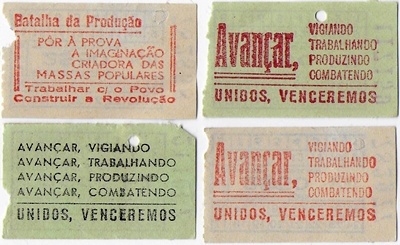 By 1975, after the Portuguese Revolution, the basic fare on normal services had doubled, with 1 or 2 zones (single) now costing 2$00 and 3 to 6 zones were 2$50. During the mid/late 1970s tickets often bore revolutionary slogans on their reverse (examples from 1975/76 are shown, right).
By 1975, after the Portuguese Revolution, the basic fare on normal services had doubled, with 1 or 2 zones (single) now costing 2$00 and 3 to 6 zones were 2$50. During the mid/late 1970s tickets often bore revolutionary slogans on their reverse (examples from 1975/76 are shown, right).
In contrast, left, the reverse side of tram tickets in 1971 were far more traditional. Those shown, left, (from top left to right and then bottom left to right) invite passengers respectively to advertise their products on Carris vehicles or tickets; to go to the lost property office if they lose anything whilst travelling; to advertise on tickets; to hold tight when standing on your journey; to ring the bell well in advance of the tram/bus stop; and, to be explicit as to your destination when asking the conductor for a ticket.
By 1979 one-man operation was in existence on buses but not trams. A tram ticket for a single journey of one zone in 1979 cost 3$50 if purchased in advance and 5$00 if bought from the conductor. Two szones or more now cost 7$00 or, if bought fromthe conductor, 10$00. A suburban zone ticket was an additional 3$50 in advance, or 5$00 from the conductor.
Inflation had taken off by 1985, by which date one-man tram operation was in place. A pre-bought ticket for a one-zone single journey now cost 27$50 or 55$00 for two or more zones. If bought from the driver, 67$50 got you a single ticket of any length within the city zones.
Reading Matter
João de Azevedo Lisboa: 125 anos sobre Carris. Lisboa:
Roma Editora, 1998. 151p. bibliog. (ISBN 972-8490-01-1)
A most informative guide, with text in Portuguese as well as many archive photographs in black and white and colour.
Gavin Booth, Yellow trams, orange buses: Portugal's trams and British-built city buses. Edinburgh: Bus Enthusiast, 2011. 67pp. bibliog.
An excellent all-colour book of photos with descriptive text.
B.R. King and J.H. Price, The tramways of Portugal. 4th edition. London: Light Rail Transit Association, 1995. 92pp. bibliog. maps. (ISBN 0-948106-19-0)
A revised printing appeared (1998) of this essential guide to Lisbon and other Portuguese tramways. There are also brief sections on the Estoril Line railway, funiculars, the Metropolitano de Lisboa and the Sintra tramway. Illustrated with many black and white photographs, this book gives historical detail, fleet lists and up-to-date information.
J. Abdo, Tram tours of Lisbon Lisboa: Modocromia, 2015. 128pp "First edition" - actually this is really the third edition, see below...
The 2015 edition is a handy, full-colour guide to the surviving tram routes in Lisbon (i.e. routes 12,15,18,25,28 and a short Chiado tram route). The true first edition was Tram tours of Lisbon, Lisbon: Represse, 1991. 98pp. maps and the second edition was Tram tours of Lisbon: Carreiras de elétricos de Lisboa, Lisbon: Represse/Carris, 1996. 137pp.
All editions of this excellent little book detail every stop of the then extant tram routes of Lisbon, accompanied by high-quality colour photographs. The first edition was in English only, the second edition covered fewer routes due to closures but was enlarged because it had full text in both Portuguese and English. The first edition covers routes 12,15,17,18,23,24,25,28. The second edition covers routes 12,15,23,24,25,28.
Marina Tavares Dias, História do eléctrico da Carris: The history of the Lisbon trams. Lisboa: Quimera, 2001 158pp. (ISBN 972-589-066-3)
An excellent, heavily illustrated history of the Carris tram, with text in both Portuguese and English.
Neil Pulling, 'Light rail diversity in Lisbon' in Tramways & Urban Transit, no. 886, October 2011, pp.386-390.
A review of the situation on both sides of the Tagus in 2011.
DVDs of Lisbon Trams
Carro eléctrico de Lisboa: os primeiros 100 anos. Lisboa: Carris, 60 mins. Excellent review which covers other forms of transport as well as trams. Commentary in Portuguese.
Lisboa 1991 captures many of the old bogie trams and much more just before their withdrawal. Available from Premofilm.
Lisbon trams: driver's eye view. Produced by Peter Middleton, Video 125, 2010. Incorporates full length high-quality recording of routes 28 and 15 from the driver's cab, with bonus features on the Carris Museum and the Bica funicular. 85 minutes plus bonuses. Commentary in English.
Lisbon's trams: past & present. J&K Video, 9 Bassett Gardens, Osterley, Middx. 100 mins.
Pictures of Lisbon Trams
More pictures of Lisbon trams may be found on
the European Railway Server.
Further information on tram services may be found at the Carris WWW site
Links to Other Sites Covering Lisbon Trams
Unfortunately some of the folowing links have become defunct but have been left in place until new addresses can be located.
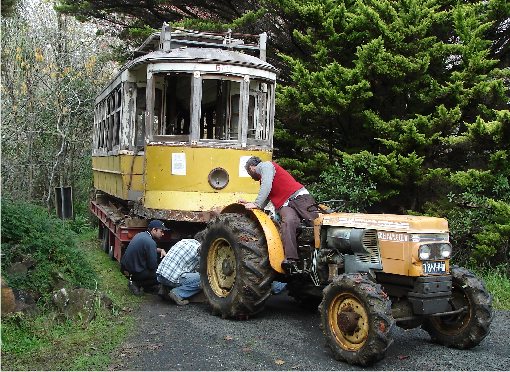 Lisbon trams turn up in the most unexpected locations as this picture (right) of #520 arriving at the workshop in Waitakere City, New Zealand, for restoration. #526 is also under restoration at the same location. Photo courtesy of Dave Harre.
Lisbon trams turn up in the most unexpected locations as this picture (right) of #520 arriving at the workshop in Waitakere City, New Zealand, for restoration. #526 is also under restoration at the same location. Photo courtesy of Dave Harre.
Hakon Kinck Gaarder,
from Oslo, Norway, has a well-designed site which includes Lisbon tram photographs in both colour and black and white.
Hans Bjorknas from
Finland has some excellent photographs of Lisbon trams, with an accompanying text which is in Swedish.
Emídio Garde
from Rio de Janeiro, Brazil, maintains a interesting site named 'Os Amarelos', ('The Yellows'),
after the traditional colours of the Carris tram car fleet.
Tramways.com has links to many pictures of Lisbon trams and also to some buses, trains and Metro images. These lack captions, however.
The New York Subway site has many pictures of Lisbon trams.
Llandudno and Colwyn Bay Tramway Society maintains a site which includes a page on Lisbon 305, which it acquired primarily to use its bogies as spares. In 2008 the body of the tram was sold to Ireland and lay in a field there in 2011. By 2016 it had been moved to Dublin where it serves (2018) as "The Tram Cafe" in Wolf Tone Square, Jervis St, North City, Dublin 1.
Mar del Plata, Argentina, on the Atlantic Ocean now hosts Lisbon trams 342 and 343. There are some excellent photos of these at Allen Morrison's webpage.
Lisbon 350 is now in Córdoba, Argentina.
Tram 530 is in Duluth, Minnesota, USA, where the Lake Superior Museum of Transportation, opened a 1/4 mile line in 1983. Lisbon 531 was sold on to Canada (see below).
A web site for Historic Railway Restoration who prepared the Lisbon car for operation in Whitehorse, Yukon. This site includes a page on Lisbon 531 being prepared for service in the Yukon, here. Also of interest is an article on Brill car 100.
The Whitehorse Trolley was the home to Lisbon 531, which was bought by the Government of Yukon in autumn, 1999 for $85,000, from Lake Superior where it had been since 1978. There is more on this here.
Information on car 346 in New Jersey.
I am endebted to Bill Robb of Canada for many of the above links.
 For a list of books on Lisbon transport in general, see the Lisbon Transport
page.
For a list of books on Lisbon transport in general, see the Lisbon Transport
page.
 SITE INDEX[Return to
SITE INDEX[Return to  Home Page]
Home Page]

[Return to Lisbon Transport Home Page][Air Museum][Azambuja Line Railway][Carris][Cascais Line Railway][Coach Museum][Eating & Drinking in Lisbon][Fertagus- Cross Tagus Railway]
[Lisbon Aviation][Lisbon Bridges][Lisbon Buses][Lisbon Cablecar][Lisbon Day Trip][Lisbon Ferries, Pt.1][Lisbon Ferries, Pt.2][Lisbon Funiculars][Lisbon Metro][Lisbon Railways, Pt.1][Lisbon Railways, Pt.2][Lisbon Railway Trips][Lisbon Ships][Lisbon Suburban Buses][Lisbon Taxis][Lisbon Trams Pt.1][Lisbon Trams Pt.2][Maritime Museum][Oporto Public Transport][Sintra Line Railway, Pt.1][Sintra Line Railway. Pt.2][Sintra Trams and Buses]

[Anglo-Portuguese Culture][Cesário Verde][Manchester's Portuguese Connections]

[Sale, Cheshire, Pt.1][SaleCheshire, Pt.2][Altrincham, Cheshire, Pt.1]

[Altrincham Football Club]
Copyright: ©
Contact: the following is not a link; please transcribe the address into your email 

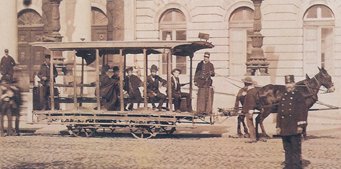
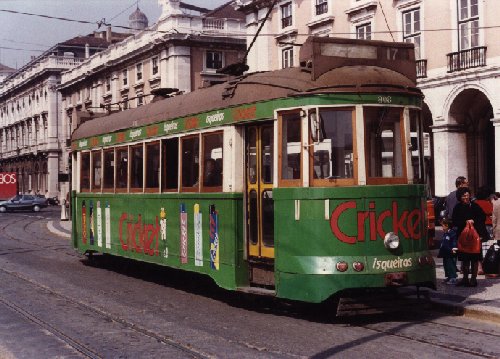
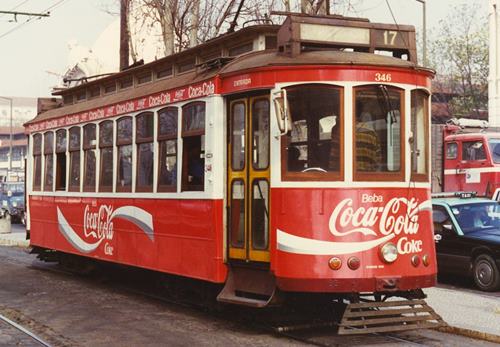

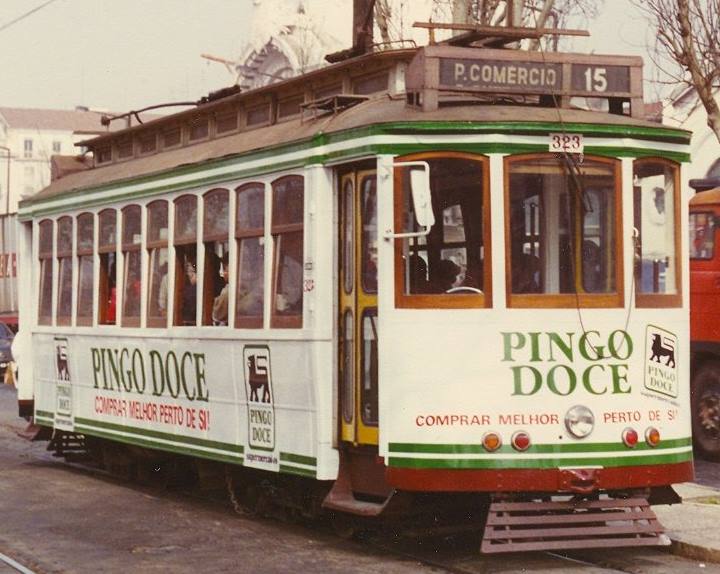
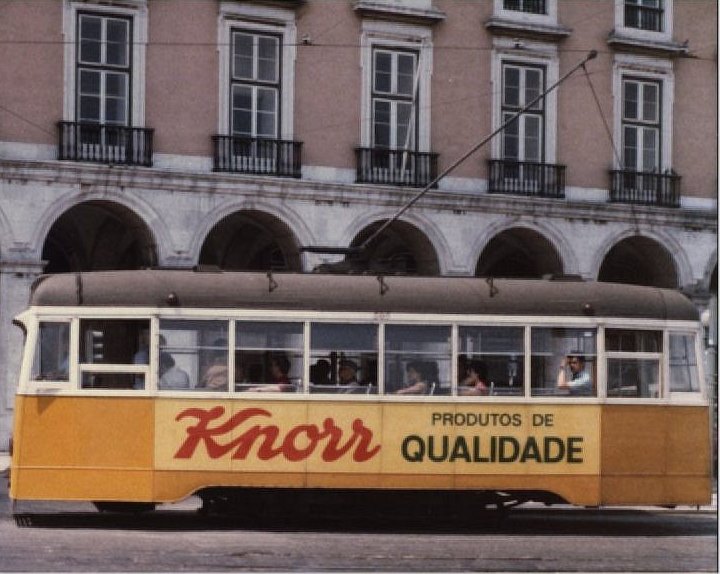
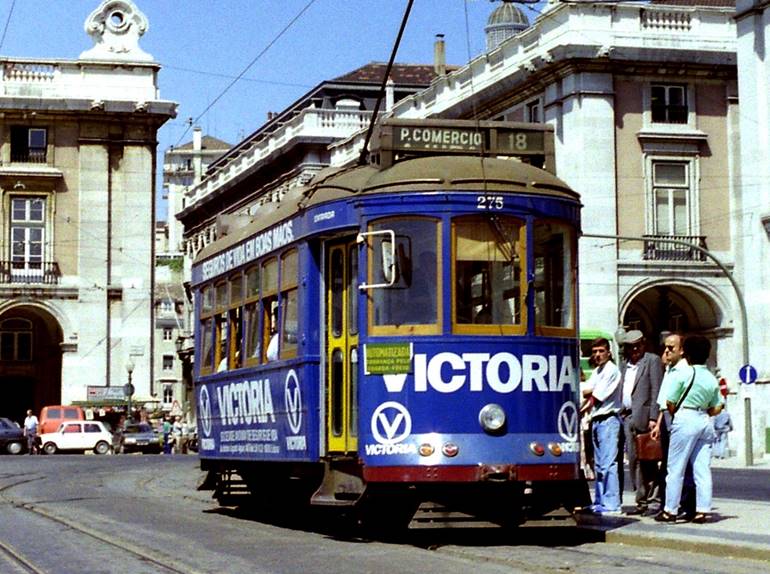
 Right: Carris's electric trams competed with Eduardo Jorge's mule cars at the start of the 20th century, as pictured in Koebel's book of 1909 (details above). Here, Jorge's mule car (right) is heading for Belém whilst a Carris "carro do povo" (workers' car) is heading into the city centre of Lisbon.
Right: Carris's electric trams competed with Eduardo Jorge's mule cars at the start of the 20th century, as pictured in Koebel's book of 1909 (details above). Here, Jorge's mule car (right) is heading for Belém whilst a Carris "carro do povo" (workers' car) is heading into the city centre of Lisbon.
















 By 1975, after the Portuguese Revolution, the basic fare on normal services had doubled, with 1 or 2 zones (single) now costing 2$00 and 3 to 6 zones were 2$50. During the mid/late 1970s tickets often bore revolutionary slogans on their reverse (examples from 1975/76 are shown, right).
By 1975, after the Portuguese Revolution, the basic fare on normal services had doubled, with 1 or 2 zones (single) now costing 2$00 and 3 to 6 zones were 2$50. During the mid/late 1970s tickets often bore revolutionary slogans on their reverse (examples from 1975/76 are shown, right).
 Lisbon trams turn up in the most unexpected locations as this picture (right) of #520 arriving at the workshop in Waitakere City, New Zealand, for restoration. #526 is also under restoration at the same location. Photo courtesy of Dave Harre.
Lisbon trams turn up in the most unexpected locations as this picture (right) of #520 arriving at the workshop in Waitakere City, New Zealand, for restoration. #526 is also under restoration at the same location. Photo courtesy of Dave Harre.
 For a list of books on Lisbon transport in general, see the
For a list of books on Lisbon transport in general, see the  SITE INDEX[
SITE INDEX[



